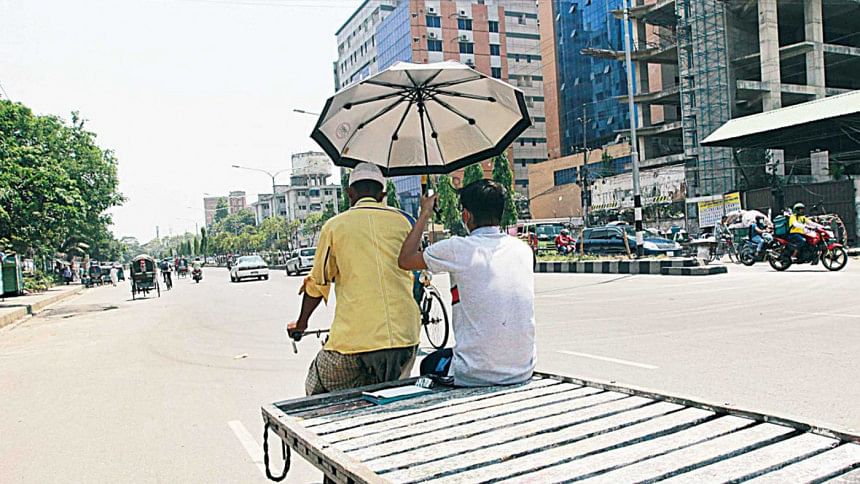The deadly urban heat that can cripple our city

In yet another sign of rapid deterioration in the quality of life in Dhaka, a recent study, published by the US-based scientific journal PNAS, has found the city to be the worst-affected around the world due to extreme urban heat. According to the study, the dramatic rise of population in Dhaka between 1983 and 2016 is one of the key reasons behind the increasing heat the city has been experiencing. It's not just Dhaka; exposure to deadly urban heat now affects around a quarter of the world's population. Some other affected cities are Shanghai and Guangzhou in China, Yangon in Myanmar, Bangkok in Thailand, and Dubai in the United Arab Emirates—which also experienced rapid population growth.
Scientists have found that rising temperatures and growing numbers of people living in urban areas combined have led to this situation, and warned that extreme heat would have devastating consequences for the urban population.
What happens when urban areas face increasing heat? According to the lead researcher of the study, in addition to increasing morbidity and mortality, extreme heat reduces people's productivity or their ability to work, resulting in lower economic output. Due to extreme heat, a total of 57.5 million people in Dhaka have lost their productivity, the study has revealed. Apart from Dhaka, cities like Cumilla and Chattogram are also affected by severe urban heat.
Around the same time, a report by the World Bank, titled "Climate Afflictions Report," has revealed yet another worrying fact. It has found that infectious diseases are increasing in Bangladesh due to hotter and longer summers, warmer winters, and extended monsoons. The report found erratic weather conditions to be the main factor behind the 2019 dengue outbreak in Dhaka.
It's mid-October now. During this time of the year, we usually expect the temperature to drop a little in the city areas. But there is hardly any sign in nature that the weather will cool down anytime soon. Rather, the city dwellers are now experiencing sweltering heat, which is affecting their ability to function properly. The World Bank report has found that not only are the summers getting hotter and the winters warmer, the monsoon is getting longer too—it now spans from February to October.
Bangladesh's temperature has increased by 0.5 degrees Celsius over the last 44 years, and is predicted to rise by another 1.4 degrees by 2050. With a one-degree rise in temperature, 9.3 percent more people are likely to suffer from respiratory diseases, while for one percent increase in humidity, there may be a 12.5 percent increase in the number of such patients, as the report has found. Extreme weather conditions can also cause mental illnesses, such as mood swings, depression, and anxiety disorders, which will become more common in the future.
The PNAS study has pointed out that global warming due to climate change has played only a 20 percent role in the temperature rise in Dhaka between 1983 and 2016, while rapid population growth and unplanned urbanisation has had an 80 percent role behind it.
Currently, the population growth rate is 2.7 percent in Dhaka, which is the highest in the world. The city's population was four million in 1983, which increased to 20 million by 2016. In addition, people are continuously coming to the capital for different purposes, so on any given day, around 60 million people live in the city, the study has revealed.
Moreover, with rapid and unplanned urbanisation, the greenery of the city has decreased to a minimum level, while the rivers and wetlands surrounding it have been filled up for illegal purposes as well as to make room for the growing population. The result of that is: Dhaka has literally become a concrete jungle. According to the Bangladesh Institute of Planners (BIP), 75 percent of the city area is now covered with concrete structures. With its greenery gone and concrete structures and asphalt surfaces trapping and concentrating heat, the temperature of the city has increased significantly.
Research has found that many areas in Dhaka, Chattogram, and Khulna are turning into "urban heat islands" due to unplanned urbanisation and development. It is feared that more of such heat islands will be created in the future if the issue is not addressed by the city authorities urgently. By now, 70 percent areas of the capital city and 60 percent areas of the port city have turned into heat islands. If the trend continues, Dhaka and Chattogram will soon become extremely climate vulnerable (Prothom Alo, April 22, 2021).
With Dhaka being severely affected by extreme heat and adverse weather patterns, and its population being exposed to infectious diseases, the residents' ability to work will decrease inevitably. The exposure to extreme heat will particularly affect the urban poor who live in slums in cramped conditions, without basic healthcare and other facilities.
If people are not able to work and function properly, if their productivity decreases from being exposed to extreme heat, what purpose will our big infrastructure development projects serve? If all our wetlands are filled up and rivers are grabbed, and all the greenery in the city is stolen, will the metro rail, the giant concrete structures mushrooming everywhere in the city, the big shopping malls and housing projects erected illegally on filled-up land let this city breathe?
To stop this worrying trend of temperature rise in Dhaka and other major cities, urgent action needs to be taken. Enough damage has already been done to our cities due to our ignorance and inaction. We have no time to waste. While we must have a national plan to fight against the impacts of climate change—which is one of the reasons behind the rise in Dhaka's temperature—reducing the population growth, focusing on planned urbanisation, increasing the greenery and reclaiming the wetlands in the city must also be given due importance if we want to save Dhaka from becoming a crippled city.
Naznin Tithi is a member of the editorial team at The Daily Star.

 For all latest news, follow The Daily Star's Google News channel.
For all latest news, follow The Daily Star's Google News channel. 



Comments